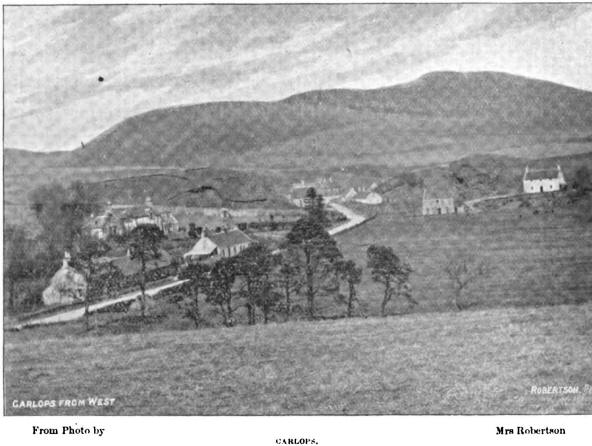|
A GALASHIELS WORTHY, many
years ago. had the misfortune to be involved in litigation which
necessitated his appearance at the Court of Session.
On his arrival home from Edinburgh, after the trial of the action, he
encountered one of his cronies who anxiously enquired how the "case” had
gone. In reply, the litigant vouchsafed the information that the judge had
taken it to avizandum. “Whaur in a’ the world is that?” was the further
query of his puzzled friend. “Weel, I hae just been thinkin’ o’ that,” came
the long drawn-out answer, “and the conclusion I hae come to is that it’s
somewhere in the neeberhood o' Carlops!"
I fear there are not a few people still who have equally hazy notions
regarding the geographical position and surroundings of this upland village.
For the information of such let me say that Carlops is on the southern slope
of the Pentlands. It lies in the northwestern corner of Peeblesshire, and is
distant only thirteen miles by road from Edinburgh. Near by is Habbie’s
Howe, the scene of Allan Ramsays delightful pastoral—“The Gentle Shepherd.”

One of the oldest and
best-known inhabitants of Carlops is William Walkinshaw, whose jubilee as a
“carrier” was celebrated a few months ago, and whose honourable career is
deserving of a notice in the Border Magazine.
Mr Walkinshaw was born at Carnwath in 1828. Amongst his earliest
recollections is that of the enthusiasm evoked by the passing of the Reform
Bill in ’32. Like most youths in those days, young Walkinshaw’s acquaintance
with school-life was strictly limited, being confined indeed to three
months. This was merely the “finish,” however, to a comparatively sound
elementary education received from his parents at home.
At the tender age of nine he was sent out to “herd,” and he continued in
farm service of one kind or another for about a dozen years. Desirous of
making some headway in the world, he was first led to think of becoming a
“carrier” by observing that a man of that occupation, who lodged in his
mother’s house, seemed always to have a plentiful supply of ready cash. At
length an opportunity of starting in this business presented itself, when
his “cadger” friend retired, and Walkinshaw decided to make the venture. The
route to which he thus succeeded, and which he has now traversed for over
half a century, embraces the strip of country that lies between Carnwath and
Edinburgh. His transactions are chiefly with farmers and shepherds, whose
dairy produce, etc., he purchases and duly disposes of in the Edinburgh
market. But Mr Walkinshaw’s business is not, by any means, limited to one
department. He accepts parcels for delivery at his various points of call,
and also supplies his country patrons, on due notice being given, with goods
of any description which they may require from the city. He thus acts as a
connecting link between the busy metropolis and the shepherd’s cottage on
the lonely moor.
One feature of Mr Walkinshaw’s business methods is that all his dealings are
for cash. He pays the seller on the spot for his merchandise and is thus
able to buy on the most favourable terms. Another characteristic of the man
is his regularity and punctuality. It is said that you can “time” your clock
by the tumble of his cart as it passes your door, and those who have goods
to despatch or receive may calculate on his arrival to a minute.
During these many years Mr Walkinshaw has not once failed to overtake his
round of calls in town or country. He has faced many a “blizzard” and been
well-nigh frozen in his cart, but never has he turned back, nor has he ever
been kept at home through sickness. Such a record for fifty years is surely
unique!
It is needless to say that the carrier has witnessed many changes since
first he took to the road. Every farm along the route has changed hands—in
most cases, repeatedly. Of all the carriers who made the journey between
Edinburgh and Lanarkshire fifty years ago he is the sole survivor. It would
appear, indeed, as if, with the extension of railways, the vocation of
“carrying” or “cadging” was doomed to extinction. In 1849 thirty carriers
stood in the same market at High Street, Edinburgh, selling their “produce.”
Now, in spite of the greater population of the city, there are only two — Mr
Walkinshaw and another.
Our friend has resided in the same house at Carlops since shortly after he
started business. It was, therefore, fitting that on the celebration of his
jubilee a short time ago his neighbours and customers should present him
with an enlarged and handsomely-framed photograph of his abode, the carrier
himself, along with his horse, cart, and dog being in the foreground. The
photo is the work of one who is not unknown to readers of the Border
Magazine—Mrs Robertson, West Linton (formerly of Peebles)—and it has been
greatly admired.

Although Mr Walkinshaw has
passed the allotted span of human life he is still in vigorous health, and
plies his calling with undiminished zest—a testimony surely to the
healthiness of open-air occupation. His favourite pastime for forty years
has been draughts, and he is recognised as the most scientific and skilful
player in Peeblesshire. He also indulges during the season in curling. In
his earlier days he was fond of a game at quoits which, at one period, was
an exceedingly popular form of recreation in rural districts. A proud boast
of Carlopians thirty or forty years ago was that they possessed amongst them
the champion quoiter of the world! This redoubtable personage was a brother
of the carrier, but the game has long since fallen into desuetude in Carlops
as elsewhere.
It is the hope of those who know him that the honest and kindly carrier may
be spared to enjoy a green old age, and that for him the “last journey” may
still be far ahead. |
